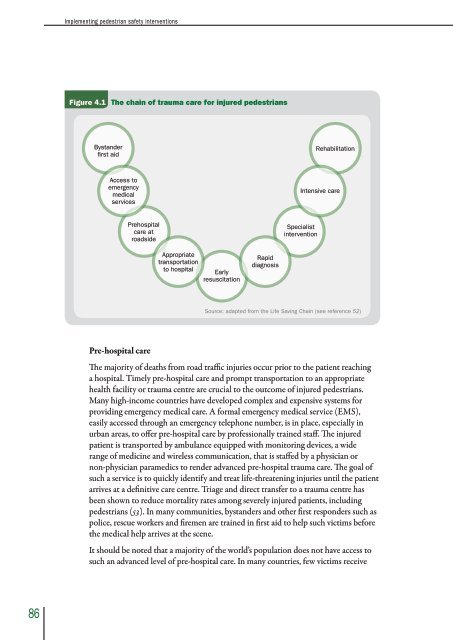Pedestrian safety - Global Road Safety Partnership
Pedestrian safety - Global Road Safety Partnership
Pedestrian safety - Global Road Safety Partnership
You also want an ePaper? Increase the reach of your titles
YUMPU automatically turns print PDFs into web optimized ePapers that Google loves.
Implementing pedestrian <strong>safety</strong> interventions<br />
Figure 4.1 The chain of trauma care for injured pedestrians<br />
Bystander<br />
first aid<br />
Rehabilitation<br />
Access to<br />
emergency<br />
medical<br />
services<br />
Intensive care<br />
Prehospital<br />
care at<br />
roadside<br />
Specialist<br />
intervention<br />
Appropriate<br />
transportation<br />
to hospital<br />
Early<br />
resuscitation<br />
Rapid<br />
diagnosis<br />
Source: adapted from the Life Saving Chain (see reference 52)<br />
Pre-hospital care<br />
The majority of deaths from road traffic injuries occur prior to the patient reaching<br />
a hospital. Timely pre-hospital care and prompt transportation to an appropriate<br />
health facility or trauma centre are crucial to the outcome of injured pedestrians.<br />
Many high-income countries have developed complex and expensive systems for<br />
providing emergency medical care. A formal emergency medical service (EMS),<br />
easily accessed through an emergency telephone number, is in place, especially in<br />
urban areas, to offer pre-hospital care by professionally trained staff. The injured<br />
patient is transported by ambulance equipped with monitoring devices, a wide<br />
range of medicine and wireless communication, that is staffed by a physician or<br />
non-physician paramedics to render advanced pre-hospital trauma care. The goal of<br />
such a service is to quickly identify and treat life-threatening injuries until the patient<br />
arrives at a definitive care centre. Triage and direct transfer to a trauma centre has<br />
been shown to reduce mortality rates among severely injured patients, including<br />
pedestrians (53). In many communities, bystanders and other first responders such as<br />
police, rescue workers and firemen are trained in first aid to help such victims before<br />
the medical help arrives at the scene.<br />
It should be noted that a majority of the world’s population does not have access to<br />
such an advanced level of pre-hospital care. In many countries, few victims receive<br />
86






